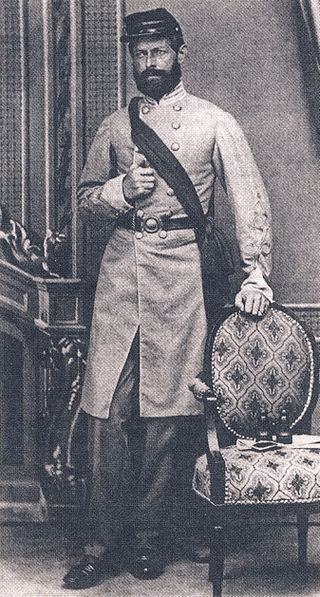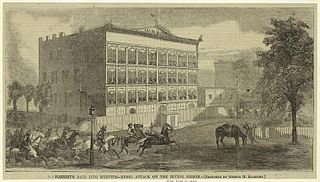
The Irving Blockprison was a wartime prison in Memphis, Tennessee, during the American Civil War. Notorious for its cruel and unsanitary living conditions, it was also known as the "Bastille" of Memphis. [1]

The Irving Blockprison was a wartime prison in Memphis, Tennessee, during the American Civil War. Notorious for its cruel and unsanitary living conditions, it was also known as the "Bastille" of Memphis. [1]
The building that later became used as the Irving Block Prison was constructed in 1860 on Second Street in Memphis, as an office building. To protect the building from burglary, iron slats covered the windows. During the Civil War, it was converted into a Confederate Hospital by the Southern Mothers organization. [2] After the capture of Memphis by the Union Army in 1862, it was turned into a prison to house soldiers and civilian Confederate sympathizers, including women and Memphis mayor John Park.
In 1862, General Ulysses S. Grant appointed Stephen A. Hurlbut in charge of Memphis and the Irving Block prison. Hurlbut had been instructed to crack down on Confederate sympathizers and the smuggling of cotton, but instead set up an extortion ring to profit from the turmoil in the city. Hurlbut also began extorting money from Memphis merchants, imprisoning them in Irving Block on false charges of espionage and demanding exorbitant bond fees, then never calling the accused to return to court, keeping the bond or sometimes finding them guilty in absentia as an excuse to confiscate the rest of their property. [1]
Hurlbut appointed Captain George A. Williams prison commandant in 1863, and together they expanded the extortion ring to include the commanding officers at the Irving Block prison. Williams was emboldened by their success, demanding ransoms from wealthy residents who sought to release captive soldiers from confinement at the prison. John Hallum, a Memphis lawyer, wrote publicly about Hulbut and Williams' crimes and uncovered a scandal involving Hurlbut, making him a liability to Hurlbut's operation. Hallum was arrested and confined at Fort Pickering, where he nearly died from the deteriorating conditions. The notoriety surrounding Hallum's arrest brought about a War Department inspection of Irving Block in 1864. [1]
As the war intensified, the situation grew worse, and some prisoners remained in chains for months at a time, receiving little food or medical attention. Complaints about the conditions in the prison prompted an investigation by Judge Advocate General Joseph Holt, who wrote President Abraham Lincoln in April 1864 that Lt. Col. John F. Marsh found the prison conditions to be unacceptable. [2] The report detailed Marsh's first hand account of the prison, stating:
The prison which is used for the detention of citizens, prisoners of war on their way to the North, and the United States soldiers awaiting trial and which is located in a large block of stores is represented as the filthiest place the inspector ever saw occupied by human beings. The whole management and government of the prison could not be worse! Discipline and order are unknown. Food sufficient but badly served. In a dark wet cellar I found twenty-eight prisoners chained to a wet floor, where they had been constantly confined, many of them for several months, one since November 16, 1863, and are not for a moment released even to relieve the calls of nature. With a single exception these men have had no trial. [3]
In April 1864, an officer reported to War Secretary Edwin Stanton of the shockingly inhuman conditions that the prisoners were kept in, leading to Stanton dismissing Captain Williams from his post. [1] [4] However, General Grant intervened on Williams' behalf, and Williams was reinstated as prison commandant. [3] After Williams returned to the prison, and after the removal of Hurlbut from command, Williams dissolved the extortion ring and resolved to clean up the prison. In July 1864, the prison was officially designated a U.S. Military Prison. [1]
During the war, Confederate Major General Nathan Bedford Forrest became determined to free the prisoners from Irving Block, and led a raid on Memphis in August 1864 to accomplish this goal and free captured Confederate Generals. He didn't find the generals, although one did manage to escape during the night with 500 other prisoners, and he was successful in influencing Union forces to return to Memphis from northern Mississippi. [3]
The prison was so notorious that it was eventually closed by order of President Lincoln himself in 1865. [3] At that time the prison held about 1200 soldiers and 100 citizens. [5] The building was condemned and demolished during the Great Depression in 1937. [2]

Libby Prison was a Confederate prison at Richmond, Virginia, during the American Civil War. In 1862 it was designated to hold officer prisoners from the Union Army, taking in numbers from the nearby Seven Days battles and other conflicts of the Union's Peninsular campaign to take Richmond and end the war only a year after it had begun. As the conflict wore on the prison gained an infamous reputation for the overcrowded and harsh conditions. Prisoners suffered high mortality from disease and malnutrition. By 1863, one thousand prisoners were crowded into large open rooms on two floors, with open, barred windows leaving them exposed to weather and temperature extremes.

Henry Wirz was a Swiss-American convicted war criminal who served as a Confederate Army officer during the American Civil War. He was the commandant of Andersonville Prison, a Confederate prisoner-of-war camp near Andersonville, Georgia, where nearly 13,000 Union Army prisoners of war died as a result of inhumane conditions. After the war, Wirz was tried and executed for conspiracy and murder relating to his command of the camp; this made the captain the highest-ranking soldier and only officer of the Confederate Army to be sentenced to death for crimes during their service. Since his execution, Wirz has become a controversial figure due to debate about his guilt and reputation, including criticism over his personal responsibility for Andersonville Prison's conditions and the quality of his post-war trial.

The Battle of Fort Pillow, also known as the Fort Pillow Massacre, was fought on April 12, 1864, at Fort Pillow on the Mississippi River in Henning, Tennessee, during the American Civil War. The battle ended with Confederate soldiers commanded by Major General Nathan Bedford Forrest massacring Union soldiers attempting to surrender. Military historian David J. Eicher concluded: "Fort Pillow marked one of the bleakest, saddest events of American military history."

The Andersonville National Historic Site, located near Andersonville, Georgia, preserves the former Andersonville Prison, a Confederate prisoner-of-war camp during the final fourteen months of the American Civil War. Most of the site lies in southwestern Macon County, adjacent to the east side of the town of Andersonville. The site also contains the Andersonville National Cemetery and the National Prisoner of War Museum. The prison was created in February 1864 and served until April 1865.

Castle Thunder, located between what is now 17th Street and 18th Street on northern side of E Cary Street in Richmond, Virginia, was a former tobacco warehouse, located on Tobacco Row, converted into a prison used by the Confederacy to house civilian prisoners, including captured Union spies, political prisoners and those charged with treason during the American Civil War. A large number of its inmates were sentenced to death. Even though the inmates were sometimes allowed boxes of medicine and other supplies, the prison guards had a reputation for brutality.

The Second Battle of Memphis was a battle of the American Civil War occurring on August 21, 1864, in Shelby County, Tennessee.

Cahaba Prison, also known as Castle Morgan, held prisoners of war in Dallas County, Alabama, where the Confederacy held captive Union soldiers during the American Civil War. The prison was located in the small Alabama town of Cahaba, at the confluence of the Alabama and Cahaba rivers, not far from Selma. It suffered a serious flood in 1865. At the time, Cahaba was still the county seat, but that was moved to Selma in 1866. Cahaba Prison was known for having one of the lowest death rates of any Civil War prison camp mainly because of the humane treatment from the Confederate commandant.

Camp Douglas, in Chicago, Illinois, sometimes described as "The North's Andersonville," was one of the largest Union Army prisoner-of-war camps for Confederate soldiers taken prisoner during the American Civil War. Based south of the city on the prairie, it was also used as a training and detention camp for Union soldiers. The Union Army first used the camp in 1861 as an organizational and training camp for volunteer regiments. It became a prisoner-of-war camp in early 1862. Later in 1862 the Union Army again used Camp Douglas as a training camp. In the fall of 1862, the Union Army used the facility as a detention camp for paroled Confederate prisoners.

Johnson's Island is a 300-acre (120 ha) island in Sandusky Bay, located on the coast of Lake Erie, 3 miles (4.8 km) from the city of Sandusky, Ohio. It was the site of a prisoner-of-war camp for Confederate officers captured during the American Civil War. Initially, Johnson's Island was the only Union prison camp exclusively for Confederate officers but eventually it held privates, political prisoners, persons sentenced to court martial and spies. Civilians who were arrested as guerrillas, or bushwhackers, were also imprisoned on the island. During its three years of operation, more than 15,000 men were incarcerated there.

Andersonville is a 1996 American television film directed by John Frankenheimer about a group of Union soldiers during the American Civil War who are captured by the Confederates and sent to an infamous Confederate prison camp.

Camp Chase was a military staging and training camp established in Columbus, Ohio, in May 1861 after the start of the American Civil War. It also included a large Union-operated prison camp for Confederate prisoners during the American Civil War.

During the American Civil War (1861–1865), Washington, D.C., the capital city of the United States, was the center of the Union war effort, which rapidly turned it from a small city into a major capital with full civic infrastructure and strong defenses.

Elmira Prison was originally a barracks for "Camp Rathbun" or "Camp Chemung", a key muster and training point for the Union Army during the American Civil War, between 1861 and 1864. The 30-acre (120,000 m2) site was selected partially due to its proximity to the Erie Railroad and the Northern Central Railway, which crisscrossed in the midst of the city. The Camp fell into disuse as the war progressed, but its "Barracks #3" was converted into a military prison in the summer of 1864. It was the prison holding the largest number of Confederate POWs. Its capacity was 4,000, but it held 12,000 within one month of opening. A different source says that Camp Rathbun had a capacity of 6,000 recruits, but that it was turned into a prison for 10,000 and the Union Commissary General was given just 10 days to make it happen.

Camp Morton was a military training ground and a Union prisoner-of-war camp in Indianapolis, Indiana, during the American Civil War. It was named for Indiana governor Oliver Morton. Prior to the war, the site served as the fairgrounds for the Indiana State Fair. During the war, Camp Morton was initially used as a military training ground. The first Union troops arrived at the camp in April 1861. After the fall of Fort Donelson and the Battle of Shiloh, the site was converted into a prisoner-of-war camp. The first Confederate prisoners arrived at Camp Morton on February 22, 1862; its last prisoners were paroled on June 12, 1865. At the conclusion of the war, the property resumed its role as the fairgrounds for the Indiana State Fair. In 1891 the property was sold and developed into a residential neighborhood known as Morton Place, a part of the Herron-Morton Place Historic District.
The Dix–Hill Cartel was the first official system for exchanging prisoners during the American Civil War. It was signed by Union Major General John A. Dix and Confederate Major General D. H. Hill at Haxall's Landing on the James River in Virginia on July 22, 1862.

The Immortal Six Hundred were 600 Confederate officers who were held prisoner by the Union Army in 1864–65. In the summer of 1863, the Confederacy passed a resolution stating all captured African-American soldiers and the officers of colored troops would not be returned. The resolution also allowed for any captured officer of colored troops to be executed and any captured African-American soldier be sold into slavery. The resolution caused a breakdown in the exchange of captured soldiers as the Union demanded all soldiers be treated equally. The Immortal Six Hundred were one group of officers who could not be exchanged.

The Lincoln American Tower is a 22-story building located at the corner of North Main and Court streets in Memphis, Tennessee. It is also a historical landmark, one of the first steel frame skyscrapers built in Memphis. The tower underwent a six-year refurbishing project starting in 2002, and despite a fire in 2006, is now open and accepting tenants.
The Memphis Battery Light Artillery (African Descent) was an artillery battery that served in the Union Army during the American Civil War. The unit was also called 1st Tennessee Battery (African Descent).

Between 1861 and 1865, American Civil War prison camps were operated by the Union and the Confederacy to detain over 400,000 captured soldiers. From the start of the Civil War through to 1863 a parole exchange system saw most prisoners of war swapped relatively quickly. However, from 1863 this broke down following the Confederacy's refusal to treat black and white Union prisoners equally, leading to soaring numbers held on both sides.
Eugene B. Van Camp was an espionage agent for the Confederate States of America during the American Civil War, assisting his father Dr. Aaron A. Van Camp in his spying activities.